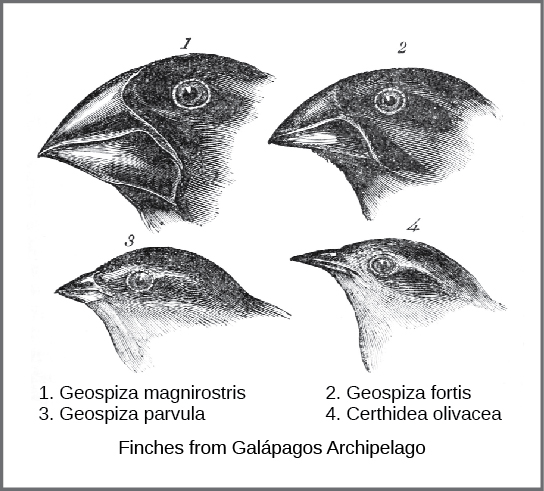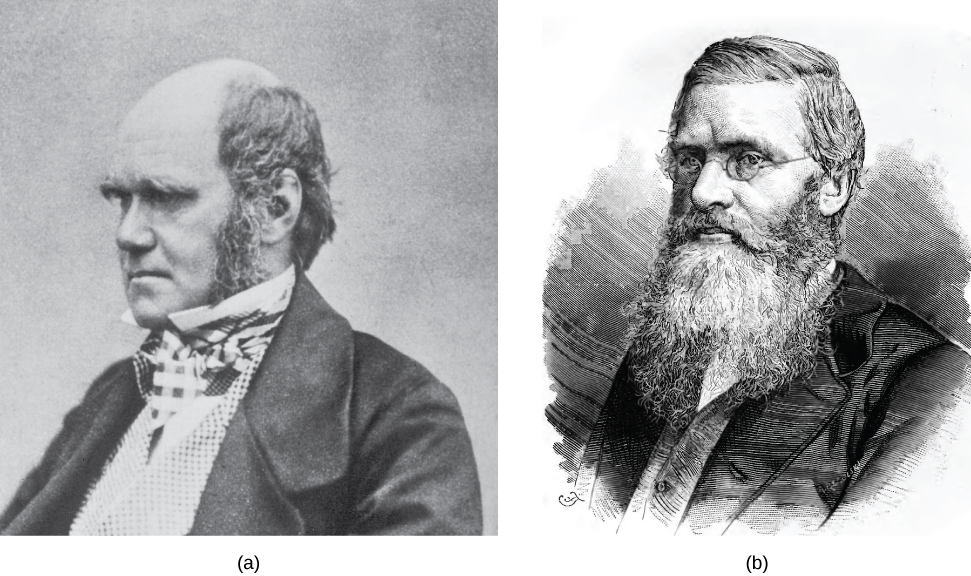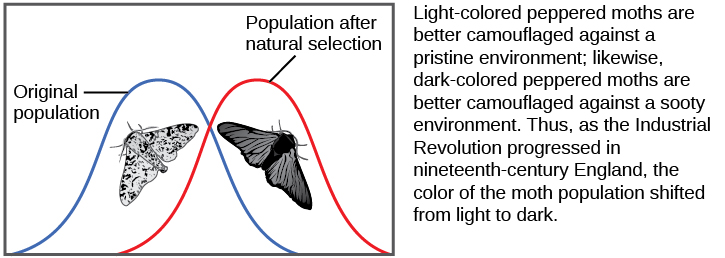What Is A Change In The Genetic Makeup Of A Population Or Species Over Time?
Theme 1: What Makes United states Unique?
i.3 The Genetic Footing of Evolution
Evolution is divers as a change in traits in a population over fourth dimension. Small changes in the frequencies of specific traits from i generation to the next are typically referred to every bit micro-evolution. Bigger changes- such as one species diverging into ii over many, many generations, are typically referred to as macro-evolution. In this grade nosotros will examine several mechanisms by small changes can happen within populations over generations (micro-evolution) also as expect at how these changes accumulate to create the diverse species we see today (macro-evolution). Nosotros will focus on human evolution- understanding how humans chronicle to other species and what this means well-nigh our characteristics, as well every bit how humans continue to evolve. In improver to this text, your lab transmission provides a bones overview of mechanisms of evolution with examples.
*
Evolution is the Source of New Species
All species of living organisms evolved at some point from a mutual ancestor. Although it may seem that living things today stay much the aforementioned from generation to generation, that is not the case: development is ongoing. Development is the procedure through which the characteristics of species change and through which new species arise.
The theory of evolution is a unifying theory of biology, meaning information technology is a framework within which biologists inquire questions nigh the living world. Its power is that information technology provides direction for predictions virtually living things that are borne out in experiment after experiment. The Ukrainian-born American geneticist Theodosius Dobzhansky famously wrote that "cipher makes sense in biology except in the low-cal of development." [1] He meant that the principle that all life has evolved and diversified from a mutual ancestor is the foundation from which nosotros empathize all other questions in biology. This chapter volition explicate some of the mechanisms for evolutionary change and the kinds of questions that biologists can and take answered using evolutionary theory.
Natural Selection is a Mechanism of Development
The theory of evolution by natural pick describes a mechanism for species change over time. That species alter had been suggested and debated well before Darwin. The view that species were static and unchanging was grounded in the writings of Plato, yet there were also ancient Greeks that expressed evolutionary ideas.
*
Charles Darwin and Natural Selection
Natural selection as a mechanism for evolution was independently conceived of and described by two naturalists, Charles Darwin and Alfred Russell Wallace, in the mid-nineteenth century. Importantly, each spent time exploring the natural world on expeditions to the torrid zone. From 1831 to 1836, Darwin traveled effectually the world onH.M.S. Beagle, visiting Southward America, Commonwealth of australia, and the southern tip of Africa. Wallace traveled to Brazil to collect insects in the Amazon rainforest from 1848 to 1852 and to the Malay Archipelago from 1854 to 1862. Darwin'south journeying, like Wallace'south afterwards journeys in the Malay Archipelago, included stops at several isle chains, the concluding being the Galápagos Islands (west of Republic of ecuador). On these islands, Darwin observed species of organisms on different islands that were clearly similar, nevertheless had singled-out differences. For example, the basis finches inhabiting the Galápagos Islands comprised several species that each had a unique bill shape ( Figure 1 ). He observed both that these finches closely resembled another finch species on the mainland of South America and that the group of species in the Galápagos formed a graded series of bill sizes and shapes, with very small differences between the virtually like. Darwin imagined that the island species might be all species modified from one original mainland species. In 1860, he wrote, "Seeing this gradation and variety of structure in one small, intimately related grouping of birds, 1 might really fancy that from an original paucity of birds in this archipelago, ane species had been taken and modified for different ends.[2]

Wallace and Darwin both observed similar patterns in other organisms and independently conceived a mechanism to explain how and why such changes could take place. Darwin called this mechanism natural selection.Natural selection, Darwin argued, was an inevitable outcome of three principles that operated in nature. Commencement, the characteristics of organisms are inherited, or passed from parent to offspring. 2nd, more offspring are produced than are able to survive; in other words, resources for survival and reproduction are limited. The capacity for reproduction in all organisms outstrips the availability of resources to support their numbers. Thus, at that place is a competition for those resources in each generation. Both Darwin and Wallace's understanding of this principle came from reading an essay by the economist Thomas Malthus, who discussed this principle in relation to homo populations. Third, offspring vary among each other in regard to their characteristics and those variations are inherited. Out of these three principles, Darwin and Wallace reasoned that offspring with inherited characteristics that let them to best compete for limited resources will survive and have more than offspring than those individuals with variations that are less able to compete. Because characteristics are inherited, these traits will be improve represented in the next generation. This will lead to change in populations over generations in a process that Darwin chosen "descent with modification."
Papers by Darwin and Wallace ( Figure ii ) presenting the idea of natural choice were read together in 1858 before the Linnaean Order in London. The following yr Darwin'south book, On the Origin of Species,was published, which outlined in considerable particular his arguments for evolution by natural pick.

Demonstrations of evolution past natural choice tin can exist time consuming. One of the best demonstrations has been in the very birds that helped to inspire the theory, the Galápagos finches. Peter and Rosemary Grant and their colleagues have studied Galápagos finch populations every year since 1976 and have provided important demonstrations of the operation of natural option. The Grants establish changes from one generation to the adjacent in the beak shapes of the medium ground finches on the Galápagos island of Daphne Major. The medium basis finch feeds on seeds. The birds have inherited variation in the bill shape with some individuals having wide, deep bills and others having thinner bills. Large-billed birds feed more efficiently on big, hard seeds, whereas smaller billed birds feed more efficiently on small, soft seeds. During 1977, a drought period altered vegetation on the island. Afterwards this menstruum, the number of seeds declined dramatically: the refuse in pocket-size, soft seeds was greater than the decline in large, hard seeds. The large-billed birds were able to survive ameliorate than the pocket-sized-billed birds the following year. The year following the drought when the Grants measured pecker sizes in the much-reduced population, they found that the boilerplate neb size was larger ( Figure three ). This was clear evidence for natural selection (differences in survival) of beak size caused past the availability of seeds. The Grants had studied the inheritance of bill sizes and knew that the surviving big-billed birds would tend to produce offspring with larger bills, so the selection would atomic number 82 to evolution of bill size. Subsequent studies past the Grants accept demonstrated selection on and development of bill size in this species in response to changing weather condition on the island. The evolution has occurred both to larger bills, as in this case, and to smaller bills when large seeds became rare.

Variation and Adaptation
Natural selection can only have place if in that location is variation, or differences, among individuals in a population. Importantly, these differences must have some genetic basis; otherwise, pick will not atomic number 82 to change in the next generation. This is critical considering variation among individuals can be caused by non-genetic reasons, such equally an private beingness taller considering of better diet rather than unlike genes.
Genetic diversity in a population comes from 2 main sources: mutation and sexual reproduction. Mutation, a modify in Deoxyribonucleic acid, is the ultimate source of new genetic variation in any population. An individual that has a mutated factor might have a different trait than other individuals in the population. Withal, this is not ever the case. A mutation tin have one of 3 outcomes on the organisms' appearance (or phenotype):
- A mutation may affect an organism's traits in a mode that gives it reduced fitness—lower likelihood of survival, resulting in fewer offspring.
- A mutation may produce a trait with a benign effect on fitness.
- Many mutations, called neutral mutations, will have no effect on fitness.
Sexual reproduction tin also generate novel combinations of traits that may take positive or negative effects on the survival of offspring. For example, your DNA is organized into 23 pairs of chromosomes– i member of each pair is from your mother, and one from your father. Since yous inherit merely one-half of your female parent's chromosomes and only one-half of your begetter's chromosomes, and the verbal chromosomes you lot get from each is determined by take chances, you are a unique combination of your parents, with traits slightly unlike from either of parent. This re-combination of Dna at each generation gives sexually reproducing organisms like us some guaranteed variation in our populations.
A heritable trait that aids the survival and reproduction of an organism in its present environs is chosen an adaptation. An accommodation is a "friction match" of the organism to the environment. Adaptation to an surroundings comes about when a change in the range of genetic variation occurs over time that increases or maintains the lucifer of the population with its environment. The variations in finch beaks shifted from generation to generation providing accommodation to food availability.
Whether or not a trait is favorable depends on the environment at the time. The same traits do non always take the same relative benefit or disadvantage because environmental conditions can modify. For example, finches with large bills were benefited in one climate, while small bills were a disadvantage; in a different climate, the human relationship reversed.
Patterns of Evolution
The evolution of species has resulted in enormous variation in class and role. When two species evolve in different directions from a mutual signal, it is called divergent development. Such divergent evolution can be seen in the forms of the reproductive organs of flowering plants, which share the aforementioned basic anatomies; however, they can look very unlike every bit a result of pick in unlike physical environments, and adaptation to unlike kinds of pollinators ( Figure 4 ).

In other cases, similar phenotypes evolve independently in distantly related species. For example, flight has evolved in both bats and insects, and they both have structures nosotros refer to as wings, which are adaptations to flight. The wings of bats and insects, however, evolved from very different original structures. When similar structures arise through evolution independently in unlike species it is called convergent evolution. The wings of bats and insects are chosen analogous structures; they are similar in function and appearance, but do not share an origin in a common ancestor. Instead they evolved independently in the two lineages. The wings of a hummingbird and an ostrich are homologous structures, significant they share similarities (despite their differences resulting from evolutionary divergence). The wings of hummingbirds and ostriches did not evolve independently in the hummingbird lineage and the ostrich lineage—they descended from a common ancestor with wings.
*
The Modern Synthesis
The mechanisms of inheritance, genetics, were not understood at the time Darwin and Wallace were developing their idea of natural selection. This lack of agreement was a stumbling cake to comprehending many aspects of development. Darwin and Wallace were unaware of the genetics piece of work past Austrian monk Gregor Mendel, which was published in 1866, not long after publication of On the Origin of Species. Mendel's piece of work, which described the genetic basis of inheritance, was rediscovered in the early twentieth century. and integrated in what became known as the modern synthesis—the coherent understanding of the human relationship between natural option and genetics. The modern synthesis describes how evolutionary pressures, such equally natural choice, tin bear upon a population's genetic makeup, and, in plow, how this tin outcome in the gradual evolution of populations and species. The theory also connects this gradual modify of a population over fourth dimension, called microevolution, with the processes that gave rise to new species and higher taxonomic groups with widely divergent characters, called macroevolution.
*
Population Genetics
Until at present, we have divers evolution as a modify in the characteristics of a population of organisms, but backside that change in characteristics is genetic change. In population genetic terms, evolution is defined equally a alter in the frequency of specific gene in a population. Using the ABO blood organization every bit an example, the frequency of the cistron that codes for A blood poly peptide,I A, is the number of copies of that gene divided by the total number of all A, B or O blood protein coding genes in the population. For example, a report in Hashemite kingdom of jordan found a frequency ofI A to be 26.1 percentage.[iii] TheI B,I 0 blood coding genes made up 13.four per centum and lx.5 percent of the blood poly peptide coding genes respectively, and all of the frequencies add up to 100 percent. A modify in this frequency over fourth dimension would constitute evolution in the population.
I way the frequency of a particular gene in a population can change is natural selection. If the gene confers a trait that allows an individual to take more offspring that survive and reproduce, that gene, by virtue of being inherited by those offspring, will exist in greater frequency in the next generation. Since gene frequencies ever add up to 100 percent, an increase in the frequency of 1 gene always ways a corresponding decrease in i or more of the other genes. Highly beneficial genes may, over a very few generations, become "stock-still" in this way, meaning that every individual of the population volition carry the cistron. Similarly, detrimental genes may be swiftly eliminated from the gene puddle, the sum of all the genes in a population. Part of the study of population genetics is tracking how selective forces alter the frequencies of certain genes in a population over time, which can requite scientists clues regarding the selective forces that may be operating on a given population. The studies of changes in fly coloration in the peppered moth from mottled white to dark in response to soot-covered tree trunks and then back to mottled white when factories stopped producing so much soot is a classic example of studying evolution in natural populations ( Figure 5 ).

*
Section Summary
Evolution by natural selection arises from iii weather condition: individuals inside a species vary, some of those variations are heritable, and organisms have more offspring than resources can support. The consequence is that individuals with relatively advantageous variations volition exist more likely to survive and accept higher reproductive rates than those individuals with different traits. The advantageous traits will be passed on to offspring in greater proportion. Thus, the trait will take college representation in the next and subsequent generations leading to genetic alter in the population.
*
Glossary
- adaptation
- a heritable trait or beliefs in an organism that aids in its survival in its present surroundings
- analogous structure
- a construction that is similar because of evolution in response to similar selection pressures resulting in convergent evolution, not similar because of descent from a common ancestor
- convergent development
- an evolution that results in similar forms on dissimilar species
- divergent evolution
- an evolution that results in different forms in two species with a common antecedent
- genetic pool
- all of the alleles carried past all of the individuals in the population
- homologous construction
- a construction that is like considering of descent from a common ancestor
- macroevolution
- a broader calibration of evolutionary changes seen over paleontological time
- microevolution
- the changes in a population'southward genetic structure (i.e., allele frequency)
- modern synthesis
- the overarching evolutionary paradigm that took shape by the 1940s and is generally accustomed today
- natural pick
- the greater relative survival and reproduction of individuals in a population that have favorable heritable traits, leading to evolutionary alter
- population genetics
- the written report of how selective forces change the allele frequencies in a population over fourth dimension
- variation
- the multifariousness of traits in a population
Source: https://open.lib.umn.edu/humanbiology/chapter/1-3-the-genetic-basis-of-evolution/
Posted by: kirbythimakeent.blogspot.com

0 Response to "What Is A Change In The Genetic Makeup Of A Population Or Species Over Time?"
Post a Comment